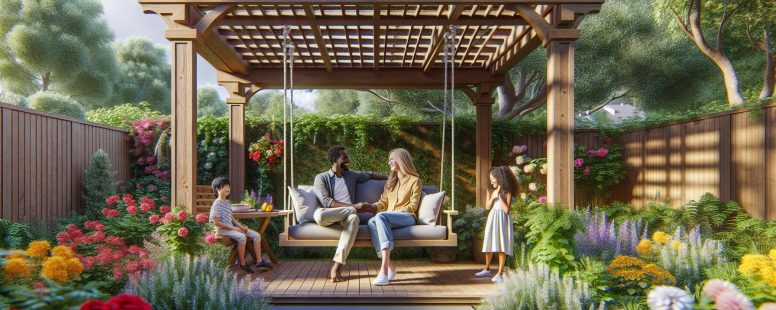Maximizing Your Pergola: A Comprehensive Guide on Safely Installing a Swing
Ever wondered if your backyard pergola could double as a swing holder? You’re not alone. Many homeowners are looking to maximize their outdoor space, and combining a pergola with a relaxing swing seems like the perfect solution.
Defining a Pergola
A pergola, at its core, represents an outdoor structure. This garden feature forms a shaded walkway or sitting area of vertical posts or pillars that support cross-beams and often includes an open lattice.
The Basics of Pergolas
Typically constructed from wood, the design options for pergolas can range widely based on personal preferences and available space. They add aesthetic value to your backyard while providing shade during hot summer days. Even though their apparent simplicity in construction terms – uprights supporting horizontal beams – they’ve gained popularity among homeowners due to the versatility offered by these structures.
For instance, many people use them as plant hangers with climbing plants such as roses or grapevines adding extra beauty and natural shade coverings over time; others opt for cloth canopy covers which provide immediate shelter against sun rays when needed but can be retracted easily too.
Variations in Pergola Designs
Pergolas differ significantly depending upon architectural style preference – traditional designs tend towards symmetry using straight lines whereas contemporary versions lean more toward asymmetry incorporating curves into design elements wherever possible without compromising structural integrity.
They also vary greatly concerning size: some may only accommodate two chairs under their small canopy while larger ones might hold several benches suitable even for group gatherings. You’ll find attached variations where one side connects directly to your house (creating sort-of extension), standalone types nestled within gardens offering peaceful retreat spots away from home’s hustle-bustle ,and those functioning dual-purpose structures like swing-holders discussed earlier here.
Understanding Swings
Let’s investigate into the intriguing area of swings. A key component to consider when envisioning your pergola as a dual-purpose structure, they add not just an element of fun but also contribute aesthetically.
Different Types of Swings
Swings come in a plethora of types, each with its unique features and requirements. For instance, porch swings offer you cozy comfort for quiet afternoons. Usually made from wood or metal, these accommodate two people comfortably.
Hammock swings take relaxation to another level by combining the swing motion with hammock-style lounging. With their fabric design often supported by spreader bars at both ends,
Finally, there are tree swings typically loved by children and adults alike for their simple yet thrilling experience – one could say it brings out the child in all! Crafted from materials such as plastic or rope seat suspended on lines,
Each type poses different considerations about weight capacity and required support structure—more reason why understanding them helps make informed decisions about installing one on your pergola.
Swing Weight Considerations
Pergolas can indeed hold up certain types of swings; but, factors like combined weight play a significant role here: 1) The actual swing – which depends largely on its material construction; 2) Occupants’ weight – accounting everyone who’ll be using it simultaneously is crucial;
An average wooden bench style swing weighs around 50-70 pounds (lbs). Similarly,a typical adult male weighs approximately 197 lbs., whereas women average around 170 lbs according to CDC reports . Hence if planning usage for multiple individuals concurrently,you’re looking at potentially supporting several hundred pounds!
It’s paramount that you ensure your pergola has been constructed robustly enough handle this load without any safety issues arising.
Can a Pergola Hold a Swing: The Primary Question
Let’s investigate into the key question at hand – can your pergola support that enticing swing? As you explore this possibility, two primary factors come to play – the structural capacity of your pergola and loads imposed by swings.
Structural Capacity of a Pergola
A typical wooden pergola demonstrates considerable strength. Often constructed from durable materials such as cedar or pine, these structures are designed for longevity. But, their ability to bear weight varies based on specific design elements.
For instance, post size plays an integral role in load-bearing capabilities; larger posts often provide increased stability compared with smaller ones. Similarly, thicker beams lend more robustness than thinner alternatives (think 2x6s vs 2x4s). Other considerations include number of supporting posts and connections between various parts (beams-to-posts or rafters-to-beams).
Another significant aspect is how well-anchored it is to its base — whether concrete patio slabs or garden soil — which impacts overall sturdiness against horizontal forces.
In essence, assessing whether your existing structure could handle additional stress requires careful evaluation taking all above factors into account.
Loads and Forces Imposed by Swings
Next comes understanding weights introduced when installing swings onto your backyard retreat spot.
Swing types contribute significantly here—porch swings typically weigh between 50-70 pounds while hammock-style variants might be lighter yet still exert pressure due to their suspension nature.
Also consider anticipated user demographics—if primarily adults would enjoy leisurely swinging sessions versus younger children—the total weight threshold shifts accordingly adding potential strain on those vertical pillars!
Also remember motion factor too! While static weight exerts constant force downwards upon our trusty cross-beams—a dynamic one like moving pendulum adds further stress across different directions testing resistance limits even more intensely!
Important Factors to Consider
When contemplating whether a pergola can support a swing, it’s crucial that you factor in some key elements. These involve the materials and construction of your pergola as well as safety considerations for installing the swing.
Evaluating Pergola Materials and Construction
The first step involves assessing the strength and durability of your existing structure. The typical wooden pergolas use robust woods such as cedar or pine, known for their considerable sturdiness. Yet remember, these characteristics alone don’t guarantee sufficient load-bearing capacity; other design features like post size, beam thickness, and anchoring methods also play critical roles here.
Take time to examine these aspects closely:
- Post Size: Larger posts generally offer more stability than smaller ones.
- Beam Thickness: Beams must be thick enough to distribute weight effectively across all points.
- Anchoring Methods: Secure anchor points increase overall structural integrity.
With this analysis completed successfully on an already installed unit or prior investing into one if you’re at planning stage – ensures longevity not only aesthetically but functionally too with safe integration of swings onto them later down line.
Ensuring Safety of Swing Installation
After determining that your pergola is structurally sound for supporting a swing installation consider additional safety factors during process itself which primarily revolves around maintaining balance under varying loads swinging motion creates causing extra stress structures need withstand smoothly without faltering apart .
Here are few tips ensure safer experience:
- Choose Right Swing Type : Different types (porch hammock tree etc) each come unique requirements cater towards so select suitable model matches perfectly along planned setup .
2 . Follow Manufacturer Guidelines carefully when setting up especially concerning hanging height dimensions related parts they give optimum performance without overburdening whole assembly excessively
3 . Regularly Check Condition perform routine inspections look out any signs wear tear could compromise its condition so posing potential hazards replace damaged components immediately maintain smooth operation keep risks minimum possible levels .
Summarising ensuring pergola hold swing involves careful assessment both its materials construction then proper installation while keeping safety paramount throughout process . It’s not just about making your backyard more fun but also safer for everyone enjoy without worrying mishaps accidents happening due overlooked aspects mentioned above.
Adding a Swing to Your Pergola: Steps and Tips
Swinging into the area of pergolas, let’s investigate into how you can add more fun by installing a swing. Given your interest in making optimal use of outdoor spaces, this article provides practical steps and tips on selecting the right swing for your pergola and important considerations during installation.
Selecting the Right Swing for Your Pergola
Selecting an appropriate swing comes down to understanding two things – design aesthetics that align with your existing structure, and weight capacity suitable for user demographics. Swings come in various types such as porch swings, hammock swings or tree swings; each offers unique features.
Porch swings are classic options often made from wood or metal that offer seating comfort similar to indoor furniture but designed specifically for outdoor durability. Hammock-style ones invite relaxation with their soft fabric seat suspended between two points creating a cozy nook perfect after long days at work. Tree style units may require additional supports but they bring back childhood memories adding charm to any backyard setup.
Remember though – not all are created equal when it comes evaluating weights these structures bear! The combined load includes both swinger’s weight along average bench weighing around 50-70 pounds thereby posing significant impact overall loading strength required underpinning structure namely yours truly here – sturdy pergola!
Installing the Swing: Crucial Tips
Installing isn’t just about hanging up chosen unit onto cross-beams—it requires strategic planning ensure safety longevity investment! Here some crucial pointers keep mind:
- Choose correct anchor point: Typically attach directly main beam less frequently top slats depending individual layout characteristics.
- Use proper hardware: Invest high-quality stainless steel chains bolts avoid rust over time guarantee secure hold.
3.Validating construction integrity is key before proceeding further particularly about elements like post size thickness anchoring methods ensuring structural stability against imposed loads swinging motion brings upon
4.Follow manufacturer guidelines: Each swing comes with a specific set of installation instructions. Ensure that these are strictly adhered to for safe usage.
5.Regular inspection and maintenance – Like any outdoor structure, your pergola needs regular upkeep especially when it’s supporting dynamic loads like swings. Inspect the chains, bolts and woodwork periodically for signs of wear or damage.
Professional Input and Advice
You’ve seen the perks of adding a swing to your pergola. It’s time now, to weigh in professional advice on when you might need an expert hand and what it entails.
When to Consult a Professional
Asking for professional help isn’t admitting defeat—it’s ensuring safety. Experts come into play under certain conditions:
- Assessing Pergola Structure: A thorough evaluation of your existing pergola is crucial before installing a swing. Professionals analyze factors like material strength, post size, beam thickness.
- Determining Weight Capacity: The weight that can be safely borne by the structure without compromising its integrity needs precise calculation—another job professionals excel at.
For example: An adult porch swing may require more robust support than a child-sized hammock chair. - Design Compatibility: Aligning aesthetics with functionality takes skill—a pro ensures this blend while considering user demographics as well.
Remember though, even experts aren’t infallible! There are advantages but also drawbacks tied up with involving them.
Pros and Cons of Professional Installation
Pros
- Safety Assurance: Safety remains paramount—professionals follow stringent standards during installation ensuring reduced risk
- Time-efficient: They bring expertise cutting down unnecessary delays from trial-and-error approaches
- Post-installation Support: Troubleshooting issues after setup? Most offer assistance here too!
- Costs Involved: High-quality service comes at a price—you’d have additional expenditure beyond just purchasing the equipment itself
- Lack Of Personalization: Customizations could get overlooked due their focus on standard procedures
Real-life Examples and Success Stories
In the quest for an outdoor oasis, many homeowners successfully merge style with functionality by integrating swings into their pergolas. This section will share real-world instances of such successful installations.
Example 1: A Charming Porch Swing Pergola
A family in Austin, Texas made headlines on a local home improvement show when they added a porch swing to their cedarwood pergola. With sturdy posts measuring 6×6 inches and robust beams offering ample support, this structure could comfortably hold the weight of three adults at once. Also, periodic maintenance checks ensured that it remained safe over time.
Example 2: Hammock Haven Underneath The Vines
An avid gardener from Portland transformed his backyard garden’s focal point using a hammock-style swing under his vine-covered pergola. He installed heavy-duty hooks onto load-bearing points along two parallel beams while ensuring he did not compromise its structural integrity or aesthetics—the perfect spot for leisurely afternoon naps!
Case Study: Tree Swing Turned Into Porch Accessory
As her children outgrew their tree swing in Florida suburbia, one creative mother repurposed it as an accessory to her white wooden pergola—providing both fun times and relaxation space! Her secret? She consulted professionals during installation who suggested reinforcing certain areas of the structure with additional bracing to ensure safety—an insightful tip worth considering if you’re planning something similar!
Remember these stories next time your creativity stirs—you might create your own beautiful blend of function and design too! Remember though; always prioritize safety alongside aesthetic appeal when adding swings onto existing structures like pergolas.
Conclusion
So, you’ve journeyed through the ins and outs of marrying a pergola with a swing. You now understand that it’s not just possible but also adds an alluring charm to your backyard setup. Remember, but: safety is paramount. Ensure your pergola can handle the weight by considering factors like post size, beam thickness and anchoring methods.
You’re equipped with tips for selecting swings matching design aesthetics while maintaining suitability for user demographics; remember those key installation aspects such as correct anchor points and quality hardware.
Consulting professionals may add cost but provides invaluable peace of mind about structural integrity – weighing these pros and cons is crucial before diving in headfirst into this project. Finally, let those success stories inspire you! From Austin’s porch swingers to Portland’s hammock enthusiasts or Florida’s creative tree-swingers – their experiences prove it’s doable when done right!
Now go ahead: explore how best to incorporate that perfect swing under your own pergola!
- Where Can I Promote a Home-Based Garden Service? Top Online & Offline Strategies to Grow Your Business - November 16, 2025
- What Permits Do I Need for a Backyard Catering Business in the US? Complete Guide 2024 - November 15, 2025
- Is It Illegal to Shoot Your Own Dog? - November 15, 2025




